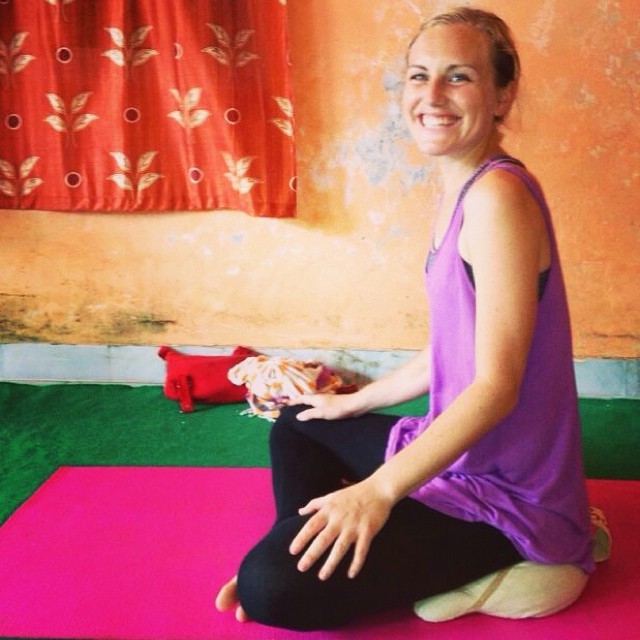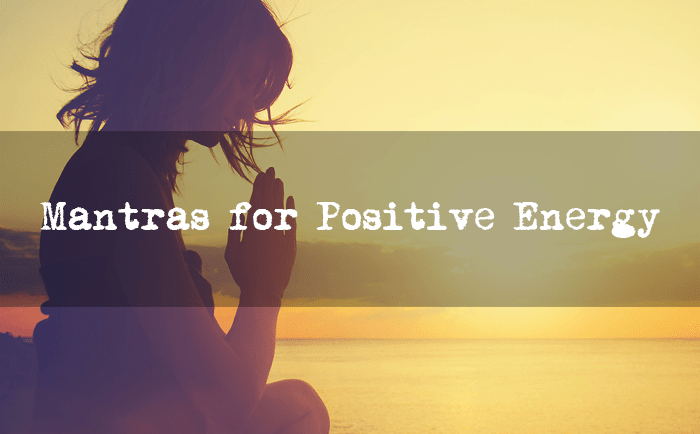What is a Mantra?
Mantra is an ancient Sanskrit word, meaning ‘sacred word, text, or charm.’ It’s been borrowed in English to mean essentially the same thing — a word or phrase that is repeated over and over.
Mantras were originally used more than 3,000 years ago by ancient yogis. They used to repeat word or phrases from sacred vedic texts to put themselves in a trance-like state and enhance their meditation practice. They believed that through repetition, they could absorb the healing power of the words into their bodies and spirit.
Today, mantras are used in yoga classes (think the three ‘Oms’ at the end of class) and in spiritual practices all over the world. You’ll find mantras used in corporate environments during their increasingly popular meditation breaks, they’re shared by influential celebrities on social media, and mantras are chanted by Buddhist monks living in the Himalayas. It seems everyone has their own mantra and is harnessing its power to change their lives.
So, what exactly are mantras, and how can their ancient wisdom benefit your life? It’s actually quite a bit more complex than just repeating a word out loud. Guru Sri Sathya Baba said, “A pure thought from a pure heart is better than a mantra.” This means that just repeating a word, phrase, or sound is not enough. You need to truly understand what you are chanting and be mindful and present, so the vibration of the sound can penetrate a busy mind, bringing calm.
The Power of Mantras
Mantras are powerful due to a combination of three elements: vibrations, repetition, and breath. The vibration of the sound, whether you’re forming words or not, can be incredibly powerful. Think of the beauty of an ancient Gregorian chant, or a vibrant ‘Om’ at the end of a yoga class where everyone participates to create one beautiful sound.
The fact is that vibrations from sound can be felt in the body and have a calming impact on our muscles and organs. The ancient yogis believed that these vibrations have healing powers that can reach straight into the soul or spirit of a person.
Modern science supports this too, showing that positive thoughts can rewire our brains. This is the basis of many cognitive behavioral therapies, where we focus on controlling our thoughts to eliminate the negative. When we say positive words or phrases, it has a very real and measurable impact on our mental state. Also, soothing sounds activate our parasympathetic nervous system, known as the “rest and digest” system.
Along with the actual words, the repetition of a mantra adds to its power. Mantras are usually repeated a minimum of three times, all the way up to hundreds of times. Traditionally, a mantra is repeated 108 times, 108 being a sacred and holy number. Mala beads can help us repeat the powerful sounds of our mantra 108 times, and through this repetition, the mantra can penetrate our mind, body and soul more deeply.
The final element is that of the breath. When chanting mantras, the words are linked with the breath, often said on the exhale followed by a pause for a deep inhale. Or sometimes there is a word tied to the inhale and another one to the exhale. For example, the traditional Sanskrit mantra of ‘So Hum’, meaning ‘I am that’, is often chanted with an inhale to ‘So’ and an exhale to the ‘Hum’.
However you match the words and breath, the combination of the two creates a type of pranayama, or breathing exercise. While repeating mantras, it is essential to breathe deep, full, slow breaths, which is relaxing in and of itself. This combined with the vibration and the repetition makes it a powerful meditation tool.
How to Say a Mantra
In order to truly harness the power of mantras and ensure that you are saying it with a pure heart, it is important to take the time to select a mantra and center yourself before chanting. Follow these tips to get the most out of your mantra.
1. Choose your mantra carefully.
Remember that it is important for your mantra to come from a pure heart, and make sure that it is a pure thought. It’s vital that you take some time first to understand the meaning behind what you are saying.
Think carefully about why you are meditating and what you hope to gain from your meditation. Are you looking for self-love, acceptance, or healing? Do you want to relax and let go of fear, or are you looking to re-energize? Choose a mantra that suits your purpose. I have a few different ones that I use, depending on my mood. When I’m stressed out and frazzled, I use the very simple and powerful ‘Let Go’. When I’m feeling fearful of something I use a very similar ‘Love Fear’, where I inhale ‘Love’ and exhale ‘Fear’. See below for more inspiration!
2. Center yourself before beginning.
Once you have chosen your mantra, take some time to center yourself. Take a few deep breaths, make sure the shoulders are nice and relaxed, the crown of the head is lifted up to the sky, and the hips are nice and heavy toward the ground. Make sure that you are comfortable.
If you have tight hips or the knees are much higher than the pelvis while sitting cross-legged, you might want to sit on a cushion or bolster to elevate the hips slightly. If cross-legged isn’t your thing, you might like to kneel, or sit on a meditation stool. Bottom line: comfort is paramount. You do not want to be cramping up in the legs or slouching at the chest while chanting your mantra.
3. Choose how you want to chant your mantra.
There are three different ways to recite your mantra: loudly, softly, and silently.
Each method has its time and place, so choose which one works for you, depending on what you need at any specific moment in time.
Chanting loudly with a focus on feeling strong vibrations is called baikhari. It is believed that the volume of the chant and the depth of the vibrations can clear negative emotions from the mind, filling up the space with positive energy. I like to chant loudly when I am really struggling with some negative emotions, like fear or anger. I use the chant to overwhelm the strength of these thoughts. These are great for group chanting as well; think of a beautiful and powerful ‘Om’ at the end of a yoga class.
Mantras that are chanted very softly are called upanshu. This style of chanting should be so soft that only the person meditating can hear. They are great for self-practice or for more gentle emotions, such as self-acceptance or peace.
The final method is chanting the mantra silently to one’s self and is known as manasic. This is often used for a larger number of repetitions, such as when practicing with mala beads. It’s also really nice to tie into a yoga practice. I love to chant to myself in a yin yoga class or restorative pose, anything where I am holding a pose for a long time and need to use my breath to soften into the pose.
As always, consider what your mind, body, and soul needs at this particular moment in time and choose accordingly.
The Best Mantras to Get You Started:
In English
I personally prefer to recite mantras in English. I feel that they are more meaningful to me in a language that I can understand. These are some of my favorites:
- Let Go: I already mentioned this one, but it really is a favorite. Tied to the breath, I inhale to say ‘Let’ and exhale to say ‘Go’. It’s a personal favorite to use in a yin yoga class or in long-hold yoga poses to help my body to unwind.
- Peace: This is one for when you’re feeling stressed and overwhelmed. I like to use it to channel inner peace, but have also used it during unsettling times to counteract negative vibrations in the world and send out a positive message. When using it in this manner, I usually chant ‘Peace’ quite loudly, allowing for the vibrations of the sound to carry.
- I change my thoughts, I change the world: This is a simple and powerful message that promotes inner peace, self-acceptance, and love. You can choose to chant it however you see fit. I personally like to chant this particular mantra over two breaths, each part on an exhale. As a result, I have less repetition than for a shorter mantra, but my heart is filled with a beautiful message.
- I am enough: You know those times, when the world is too much to bear and you feel tiny and overwhelmed and insignificant? We’ve all been there. This one is for those times. You can tie the entire phrase to one exhale, or say each word individually on an exhale. Either way, it is powerful and beautiful.
- Love, Fear: Again, another one I already mentioned, but so beautiful it is worth repeating. I also tie it to the breath, with an inhale for ‘Love’ and an exhale for ‘Fear’. It makes me feel like I truly am taking in love and eliminating fear.
In Sanskrit
Many mantras are still used in the traditional Sanskrit, the language of the ancient yogic texts. Many people prefer the more traditional mantras in Sanskrit. I like to mix it up and use Sanskrit mantras when I am feeling more spiritual, or when there is a certain one that calls me. Here are some great ones to get you started.
- So Hum: This popular mantra means ‘I am that’. It’s a beautiful phrase that promotes self-acceptance and confidence. I like to tie the ‘So’ to an inhale, and the ‘Hum’ to an exhale. When chanted out loud, individually or in a group, the vibrations are particularly powerful due to the soft nature of the sounds.
- Om: This is the classic yoga mantra, said to be the combination of all of the sounds in the world. It’s a beautiful one to chant as a group, whether just this one individual sound, or combined with ‘Om, shanti, shanti, shanti-ii’. I have also heard it chanted starting at the base of the spine with a focus on the sound sliding up the throat. In this way, it is said that the vibrations of the sound will hit each of the chakras and stimulate them. Try it and see!
- Aham Brahmasmi: This literally means ‘I Connect’, a really lovely and simple mantra for promoting connection between either the Self, yourself and another person, or even the entire universe. I love to use this one when I am focused on Mother Nature. It really nourishes me and fills me with feelings of connection to the world around me.
- Shiva Shakti: Meaning ‘I Embody’ and links Shiva and Shakti, the masculine and feminine principles in yoga. It’s a great mantra to promote balance and calm. Beautiful both to match to and inhale and exhale, or both words to an exhale.
- Moksha: Literally meaning ‘I Express’, it is linked with ideas of liberation of the mind and freedom. Great for when you feel like you are losing it, or things are beyond your control.
- Sankalpa: You may have heard of setting a Sankalpa at the start of a yoga class. It means ‘intention’ and as a mantra can be better interpreted to mean ‘I Intend’. It’s perfect for when you have a clear intention or something you want to focus on.
- Ritam: Coming from the school of Transcendental Meditation, this mantra translates to mean ‘I Perceive’. Ritam is seen as the celestial layer between thinking and consciousness. It’s one for when you need to listen to your gut, so to speak, learning to hear and trust your intuition.
- Sat Chit Ananda: This is a particularly beautiful mantra. They all are in their own way, but I find this one extra special. It could translate to ‘Truth, Consciousness, and the Fullness of Life’ but as a mantra, one of the clearest translations is ‘I Radiate’. It is associated with living life to the fullest and radiating bliss from all layers of consciousness.
- Tat Tvam Asi: Literally meaning ‘Thou Art That’, this is a perfect Sanskrit phrase, as a mantra could be better interpreted to mean ‘I Reflect’. It is linked with ideas of self-reflection and the interrelated nature of the universe.
These are but a mere few to get you started! Once you begin using mantras, there is no limit to how many times you repeat them or how bold or gentle you are in chanting. Find the one that you need in your life right now, start meditating on it, and reap the benefits for your mind, body, and spirit.
Copyright © 2021. All Rights Reserved.
***
Medical Disclaimer: The information provided here in my “Soulful Yoga” column at SoulfulLiving.com is not intended to be a substitute for the professional medical advice, diagnosis or treatment provided by your own Medical Provider. You agree and acknowledge that I am not providing medical advice. All matters regarding your health require supervision by a personal physician or other appropriate health care professional familiar with your current health status. You must not rely on the information in this column as an alternative to medical advice from your own doctor or other professional healthcare provider. Always consult a qualified personal health care provider before making any dietary or exercise changes. As with all situations, there are sometimes unknown individual risks and circumstances that can arise that cannot be foreseen that can influence or reduce results. You understand that any mention of any suggestion or recommendation in this column is to be taken at your own risk, with no liability on my part or that of SoulfulLiving.com, recognizing that there is a rare chance that illness, injury or even death could result, and you agree to assume all risks.

Stephanie Johnson is an elementary school teacher, yoga teacher, meditation student and writer. She is looking for ways to explore this beautiful, crazy life that we have been gifted and to live it with meaning. Stephanie fell in love with yoga as a teenager and has since travelled across the globe in search of knowledge and experiences to deepen her understanding of yoga, from her home country of Australia, to India and across Asia, to Chile, and the USA.
For Stephanie, yoga is life. It starts on the mat where we strengthen our physical bodies and relax our minds through pranayama and meditation, and moves into our everyday lives, so we are present for every single moment, living with mental flexibility and spiritual curiosity. Stephanie is passionate about sharing this practice with others through her teaching, writing and daily life, so that others can share in this beautiful and ancient wisdom.




